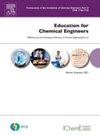在化学工程教育中利用生成式人工智能:大型语言模型ChatGPT v3.5的实现和评估
IF 2.3
2区 教育学
Q1 EDUCATION, SCIENTIFIC DISCIPLINES
引用次数: 0
摘要
随着生成式人工智能(GAI)的快速发展,包括大型语言模型(llm)的使用,高等教育机构越来越关注评估、潜在的剽窃以及最终对学生学习成果的负面影响。然而,GAI很可能在未来的专业环境中成为一个有用的工具,包括在许多化学工程相关的角色中。因此,学生必须具备负责任地、合乎道德地、安全地使用GAI的知识和技能。本研究采用IDEE(确定预期结果,确定自动化水平,确保道德,评估有效性)框架来开发化学工程实验室课程,并通过使用法学硕士来增强。作为实验前工作的一部分,一年级学生的任务是使用ChatGPT v3.5建立一个模型,预测水箱中水的排水情况。然后,他们在实验中测试了这个模型的有效性,并分析了作为实验后工作的一部分获得的数据。实验前和实验后的调查显示,学生在GAI方面的经验有限,但普遍认为这对未来的工作很有用。实验后的调查显示,绝大多数人认为这个练习帮助他们学会了如何使用法学硕士,如何合乎道德地使用它,如何批评输出,以及它的一些局限性是什么。反身性专题分析应用于同一调查中获得的定性数据。这揭示了八个不同的主题,其中一个主题表明,人们强烈意识到批评法学硕士产出的必要性,与使用法学硕士相关的潜在陷阱,以及对产出质量的担忧。因此,这项工作不仅提供了一个将法学硕士和GAI更广泛地整合到化学工程课程中的案例研究,而且还提供了对学生对这一新兴技术更普遍使用的看法的宝贵见解。本文章由计算机程序翻译,如有差异,请以英文原文为准。

Harnessing generative AI in chemical engineering education: Implementation and evaluation of the large language model ChatGPT v3.5
With the recent and rapid growth of the adoption of generative artificial intelligence (GAI), including the use of large language models (LLMs) there has been growing concern amongst higher education institutions regarding assessment, potential plagiarism, and ultimately a negative impact on student learning outcomes. However, GAI is likely to be a useful tool in future professional environments, including in many chemical engineering-related roles. It is, therefore, essential that students are equipped with the knowledge and skills to use GAI responsibly, ethically, and safely. This research adopts the IDEE (Identify desired outcomes, Determine level of automation, Ensure ethics, Evaluate effectiveness) framework to develop a chemical engineering lab session which is augmented by the use of LLMs. As part of the pre-lab work, Year 1 students were tasked with using ChatGPT v3.5 to derive a model which predicted the drainage profile of water from a tank. They then tested the validity of this model experimentally in a lab session and analysed the data obtained as part of the post-lab work. Pre- and post-lab surveys were conducted which revealed that students had limited prior experience with GAI but there was a general belief that it could be useful for future work. The post-lab survey showed that the vast majority of people believed that this exercise had helped them learn how to use LLMs, how to use it ethically, how to critique the output, and what some of its limitations were. Reflexive thematic analysis was applied to the qualitative data obtained in the same surveys. This revealed eight distinct themes, one of which showed that there was a strong awareness of the need for criticising the LLM output, of the potential pitfalls associated with its use, and concerns over the quality of the output. As such, this work provides not just a case study for the integration of LLMs, and GAI more broadly, into chemical engineering curricula, but also valuable insight into student perceptions regarding the use of this nascent technology more generally.
求助全文
通过发布文献求助,成功后即可免费获取论文全文。
去求助
来源期刊

Education for Chemical Engineers
Multiple-
CiteScore
8.80
自引率
17.90%
发文量
30
审稿时长
31 days
期刊介绍:
Education for Chemical Engineers was launched in 2006 with a remit to publisheducation research papers, resource reviews and teaching and learning notes. ECE is targeted at chemical engineering academics and educators, discussing the ongoingchanges and development in chemical engineering education. This international title publishes papers from around the world, creating a global network of chemical engineering academics. Papers demonstrating how educational research results can be applied to chemical engineering education are particularly welcome, as are the accounts of research work that brings new perspectives to established principles, highlighting unsolved problems or indicating direction for future research relevant to chemical engineering education. Core topic areas: -Assessment- Accreditation- Curriculum development and transformation- Design- Diversity- Distance education-- E-learning Entrepreneurship programs- Industry-academic linkages- Benchmarking- Lifelong learning- Multidisciplinary programs- Outreach from kindergarten to high school programs- Student recruitment and retention and transition programs- New technology- Problem-based learning- Social responsibility and professionalism- Teamwork- Web-based learning
 求助内容:
求助内容: 应助结果提醒方式:
应助结果提醒方式:


